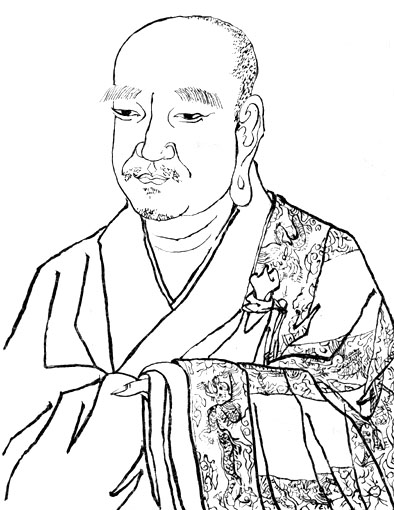
|
|
THE BODHI SEAL OF THE PATRIARCHSTHE TWENTY-FIFTH INDIAN PATRIARCHThe Venerable Basiasita The Venerable One was a native of the country of Kubha. To begin with, his mother dreamed she obtained a magic sword, and then became pregnant. When he was born, he held his left hand in a fist. His father took him to see the Patriarch Arya-Simha ("Lion") to ask him why. The Patriarch took him by the hand and said, "You can return my pearl." The Venerable One accordingly opened his hand and held up a pearl. He followed him and renounced the home life. The Patriarch shaved his head and crossed him over, saying, "I, your teacher, secretly have the Proper Dharma Eye Treasury handed down from the Arhat, which I transmit to you." After he obtained the Dharma, he hid away in mountain valleys. The King Heavenly Virtue invited him to receive offerings. Afterwards, the Prince Supreme Virtue, who then firmly believed in the dharmas of externalist ways, caused him difficulties. The Venerable One took out the robe and showed it to him. The King ordered the robe burned. The robe appeared to have the five colors and remained fresh as ever, while the firewood was used up. The King then felt remorse, and bowed to him. Later, he transmitted the Dharma robe to Punyamitra, then displayed spiritually transformed fire and cremated himself. On level ground his sharira were one foot high. A verse in praise of him says: Not yet out the door of home, He already grasped the mysterious pearl. The transmission of this robe of faith Transformed, when worn, the clan of fools. Calamities did not encroach; Fire forged a golden hue. King Supreme then felt remorse: The Dharma banner waved, aloft.
ANNOUNCING DHARMA FLOWER SUTRAVOL. IV. Chapter III "A Parable" Buddhist Text Translation Society, 370 pp., pa per bound, 8.95. After setting the stage for the speaking of The Lotus Sutra in Chapter One, (BTTS Vol. II.) the Buddha opens the provisional to reveal the real. In Chapter Two (BTTS Vol. III.) he speaks the Dharma directly, setting forth the doctrine of universal salvation by means of the One Buddha Vehicle. In Chapter Two he speaks for those of superior roots and sharp wisdom. Those of average roots and inferior roots were unable to resolve their doubts. In his great compassion, the Buddha then speaks a parable to lead those of average roots to understanding. That is Chapter Three: A Parable, the present volume. It 1s one of the most important chapters in the Sutra. For this reason, the Venerable Master Hua has commented on it at length and in detail. In the analogy there is a great elder who left his children at home and went on a journey. As he was returning, he saw that his house had caught fire. He called to his children to come out, hut they were so absorbed in their play that they paid no attention to him. The elder then used an expedient device. "Come out," he said. "I have some fine toys for you right outside the door. I have sheep carts, deer carts, and ox carts. Come out and take them;" Hearing this, the children ran from the house to safety and demanded the carts. Instead of the three carts he promised he gave them each a great white ox cart, wonderful far beyond their original hopes. The great elder is, of course, the Buddha. His children as those of the Three Vehicles and also all living beings. Playing in the burning house of the three realms, living beings continue to amuse themselves, ignoring the Buddha's warnings and unaware of the danger. The Buddha expediency offers the teachings of the Three Vehicles, but gives us instead the One Buddha Vehicle, the Great White Ox Cart. Those who study this volume will find it a treasury of lists, stories, and detailed explanations of doctrine. Studying it, we should endeavor to put its principles into practice and thereby escape the burning house of birth and death. For there's only One Vehicle in the worlds, great and small: The lotus of Dharma which blooms in us all. For there's only One Vehicle, not
two or three; Buddhas we'll be! |